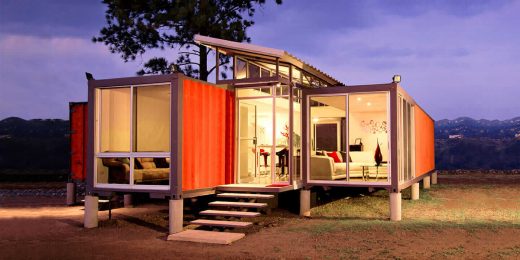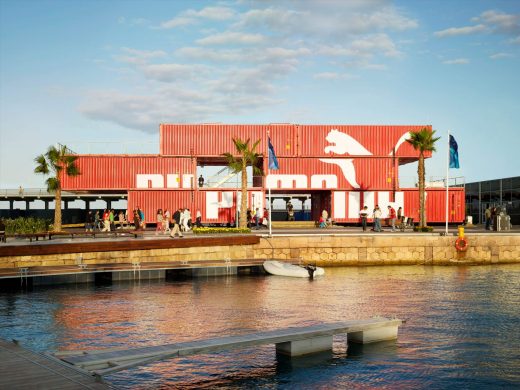Introduction
A shipping container home is a structure made of steel shipping containers, which are large, reusable and are used to transport goods. Shipping containers come in two sizes: 20 ft. × 8 ft. and 40 ft. x 8 ft. The 20-foot shipping containers have 160 square feet of living space, while the 40-foot cargo containers have 320 square feet. These containers can be used as a solo home or personal office or combined to create a multilevel residence.
Shipping container homes, along with tiny houses, RVs, and silos, are becoming increasingly popular as potential homeowners look for alternatives to the traditional multi-bedroom house. Because of the strength, durability, affordability, and sustainability of recyclable materials, shipping container homes and structures are becoming more common in our day. These are practically universally available, and these are significantly cheaper near ports.

Fig 1: A house made of a shipping container
AdvantagesSome of the advantages of such containers are-
Cost-Effective
They are usually less expensive to build than traditional homes since they require fewer building materials and manpower. By upgrading the residence using DIY abilities, these containers can reduce the cost of customised container housing. According to The Guardian, in 2015, a student reported paying €450 a month in rent while also qualifying for a €140 monthly housing subsidy. This is far less expensive than the €600 monthly rent that students in central Amsterdam spend on average.
Time-Saver
A shipping container home can be built in less than a month by some professionals. However, it can be expensive to hire an expert to make a container dream house. But a prefabricated container home can be bought from a growing list of companies that specialise in creating prefab homes off-site to avoid costly construction fees entirely.
Helpful for Homeless
Such container homes can be helpful for homeless people who have nowhere to go because of poverty. Internationally, numerous NGOs have used the concept for low-cost housing construction. For instance, Orange County has homeless California veterans in a two-story container home that opened in 2019. Sixteen apartments have basic needs in the building, and this project is the first apartment building for shipping containers in California.
Mobility
An off-the-grid single-container residence can be picked up and relocated anywhere in the world using a professional shipping transportation service. This is precisely why they are a popular kind of lodging among US military personnel. These residences are outfitted with the most up-to-date technology as well as the medications that the forces required.
Housing Crisis
Housing shortages are frequent in all of the world’s major cities. While the governments have set long-term goals to provide housing for all, container dwellings can offer a temporary solution. Containers as a frame, like prefabricated dwellings, can be moved to the location where the building must be erected. These can be stacked quickly, and then the final installations can be completed.
Durability
Corten steel is commonly used in the construction of shipping containers. During transportation over bodies of water, this self-healing steel protects cargo, thus increasing the longevity of the homes. Weathering steel shipping container homes are likely to withstand inclement weather better than traditional housing.
Protection
We have no idea what direction nature will take in the future, so we should be prepared for natural calamities. One of the most pressing demands in such a situation is to provide housing for the unfortunate people, and the displaced, container homes are the perfect solution. These dwellings, which are simple to put together, can provide immediate respite to those who have been affected by a disaster.
Disadvantages
It is essential to keep in mind specific points before constructing a home with these containers. These points are –
Restrictions
In some areas, obtaining the appropriate licences to build shipping container houses can be challenging because it is a relatively new phenomenon. Several states in the United States as well as countries abroad host shipping container homes and have restrictions in place. Hence, it is best to contact the local municipal planning office for further information on building rules, zoning restrictions, and permitting procedures for container homes.
Eco-Unfriendly
Many supporters promote container living as a terrific method to recycle old shipping containers, but some home purchasers choose to turn new shipping containers into dwellings. Depending on the history of use, used shipping containers are more environmentally benign. Used containers may sustain damage when transporting goods or have a track record of transporting hazardous chemicals. Converted shipping containers are a less appealing alternative for some potential container homeowners because of these problems.
Hassles
Many proponents promote living containers as an excellent way to recycle old containers, while some home buyers decide to convert new containers to homes. The shipment containers utilised are more environmentally friendly, depending on the usage history. However, used containers can experience damage during shipment or have a hazardous chemicals track record. For such reasons, converted shipping containers are a less attractive solution for certain potential owners of containers, given this dilemma.
Needs Supports
While storage containers are made of strong steel, specific changes, such as cutting holes for a door or huge windows, can jeopardise their structural integrity. While shipping containers may resist some weather conditions, if the corner castings aren’t robust enough, the weight of heavy snow might force the roof to bow. Hence, to reinforce load-bearing walls or to add a slanted rooftop, a contractor is needed.
Some of the examples are –
Puma City – LoT-EK
The architects created one of this magnitude’s first transportable shipping container homes to build this structure, using 24 shipping containers. It’s a three-level stack of containers that have since been sent to numerous overseas locations. The lower floors have two full retail locations, while the upper levels have offices, a press room, and storage. The top-level houses a bar, lounge, and event space, as well as a huge terrace. The structure comprises separate containers that are disassembled and covered in panels to prevent the windows from shattering during shipping. They’re put back together to construct this 1,100 square metre structure when they get to their destination.

Fig 2: Puma City
Courtesy: LOT-EK
Grillagh Water House – Patrick Bradley
Architect Patrick Bradley developed and owns the Grillagh Water House, a shipping container residence. The design of this property, which is located in Northern Ireland in the town of Maghera, was inspired by Frank Lloyd Wright’s The Falling Water. It stands as a sculpture in the middle of the farmland, and it complements and blends in with the surroundings. The upper level of this residential structure cantilevers over the lower level as it expands towards its end, with a balcony ringed by steel fins to provide shading for the interior. There is an open-plan living room on the top floor with amazing views beyond the countryside, while on the lower floor, there are intimate private areas with a toilet, boot room, and dormitory with a sliding entrance.

Fig 3: Grillagh Water House
Courtesy: Container Hacker
Indian Research Base – Bof Architekten
The project’s location, Antarctica, necessitated a stable structure that was also simple to remove. Bof Architekten devised a design that included 134 shipping containers that would define the usable spaces as well as serve as the structural system. The shipping containers needed to be wrapped with an insulated aerodynamic covering made of metal panels due to the severe conditions in the Antarctic, which included freezing temperatures and strong winds. For this aim, the skin was tested and optimised. This building has Laboratory space, storage, technical space, a CHP unit, a garage, and a workshop on the basement floor.

Fig 4: Indian Research Base
Courtesy: VICE
Conclusion
Container homes have failed to become a part of the Indian housing storey, despite the popularity of mobile offices, mobile medical services, and mobile classrooms. But things are changing as new architects and designers are making sustainable homes an option for the needy and homeless people. It has also become a trend in society, and so many people opt for it in various parts of the world.
References
- Makaan iQ, “Container Homes Have Arrived And Are Here To Stay”- https://www.makaan.com/iq/living/container-homes-have-arrived-and-are-here-to-stay
- MasterClass, “Shipping Container Homes: Understanding the Pros and Cons”- https://www.masterclass.com/articles/shipping-container-homes-understanding-the-pros-and-cons#what-is-a-shipping-container-home
- Archute, “Shipping Container Homes You Must See”- https://www.archute.com/shipping-container-homes/
If you have a query, you can ask a question here.


